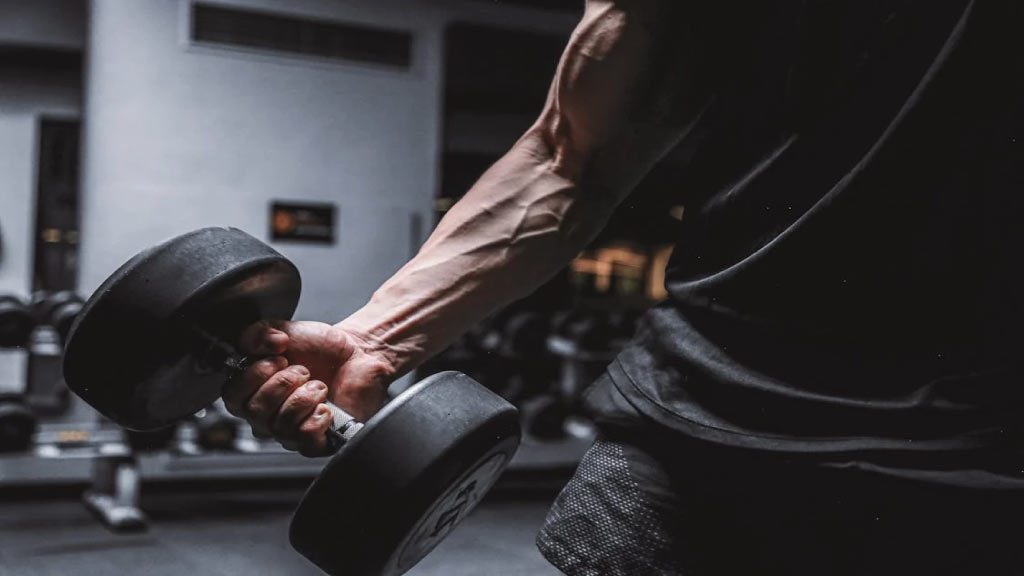7 Effective and Simple Dumbbell Exercises for Stronger Arms with Their Benefits
Tricep extensions are an essential exercise for targeting and strengthening the triceps brachii muscles, located on the back of your upper arms. To perform tricep extensions correctly, start by sitting on a bench or chair with your back straight. Hold a dumbbell with both hands overhead, ensuring a firm grip on the weight. Lower the dumbbell behind your head by bending your elbows, allowing your upper arms to remain stationary. Keep your elbows close to your head throughout the movement. Once you feel a stretch in your triceps, extend your arms back up to the starting position, fully straightening your elbows. Control the movement and avoid swinging the weight.
Benefits of Tricep Extensions:
1- Toned and Defined Arms:
Tricep extensions effectively target the triceps brachii muscles, helping to tone and define the back of the arms. Consistent training with tricep extensions can lead to improved arm definition and overall aesthetics, enhancing your confidence in sleeveless attire.
2- Improved Arm Stability:
Strengthening the triceps muscles through extensions enhances arm stability and reduces the risk of injuries during activities that involve pushing or lifting. This is particularly beneficial for athletes participating in sports such as basketball, volleyball, and swimming.
3- Enhanced Shoulder Health:
Tricep extensions require stability in the shoulder joint, leading to improved shoulder health and mobility over time. Strong triceps help support the shoulder joint during pressing movements, reducing the likelihood of overuse injuries and promoting overall shoulder stability.
4- Assists in Other Exercises:
Strong triceps are essential for performing compound exercises such as bench presses, push-ups, and overhead presses with proper form and effectiveness. By incorporating tricep extensions into your training routine, you can strengthen this muscle group and improve performance in other upper body exercises.
5- Prevents Imbalances:
Neglecting the triceps can lead to muscle imbalances between the front and back of the arms, increasing the risk of injuries and hindering overall arm development. Including tricep extensions in your workout regimen helps ensure balanced strength and symmetry in the arms, reducing the likelihood of overuse injuries.
3. Hammer Curls Dumbbell Exercises For Arms :
Hammer curls are a versatile exercise that targets the brachialis muscle beneath the biceps, contributing to balanced arm development. To perform hammer curls correctly, begin by standing with your feet shoulder-width apart. Hold a dumbbell in each hand with your palms facing your body, ensuring a firm grip on the weights. Keep your elbows close to your sides and maintain a neutral wrist position throughout the movement. As you exhale, curl the dumbbells towards your shoulders while keeping your palms facing inward. Focus on squeezing your biceps at the top of the movement. Then, inhale as you lower the dumbbells back down in a controlled manner, maintaining tension in your muscles.
Benefits of Hammer Curls:
1- Balanced Arm Development:
Hammer curls target the brachialis muscle, which lies beneath the biceps. By strengthening this muscle, hammer curls promote balanced arm development, ensuring that both the front and back of your arms receive adequate training. This balance is essential for overall arm aesthetics and functional strength.
2- Enhanced Wrist Stability:
Unlike traditional bicep curls, hammer curls keep your palms facing inward throughout the movement. This grip position not only works the brachialis effectively but also enhances wrist stability. Over time, hammer curls can help strengthen the muscles and connective tissues in your wrists, reducing the risk of injuries during lifting and other activities.
3- Improved Forearm Strength:
Hammer curls engage the muscles in your forearms to a significant degree, particularly the brachioradialis. This muscle plays a crucial role in forearm flexion and pronation, contributing to overall grip strength and forearm stability. Regularly incorporating hammer curls into your workout routine can lead to noticeable improvements in forearm strength and endurance.
4- Versatile Exercise Variation:
Hammer curls offer a versatile variation to traditional bicep curls, providing a different stimulus to your arm muscles. By alternating between hammer curls and other bicep exercises, you can ensure comprehensive arm development while preventing boredom and plateaus in your training. Additionally, the simplicity of hammer curls makes them accessible to individuals of all fitness levels, from beginners to advanced lifters.
5- Functional Movement Patterns:
The motion of hammer curls mimics several real-life activities that involve lifting or carrying objects with a neutral grip. By strengthening the muscles involved in this movement pattern, such as the brachialis and brachioradialis, hammer curls can improve your ability to perform daily tasks with ease and efficiency. Whether you’re lifting groceries, moving furniture, or participating in sports, strong and stable arms are invaluable for maintaining an active lifestyle.
4. Dumbbell Exercises For Arms Shoulder Press:
Shoulder presses are a fundamental exercise for developing strength and stability in the deltoid muscles, which are located on the outer part of your shoulders. To perform shoulder presses correctly, you can either sit on a bench with back support or stand with your feet hip-width apart. Hold a dumbbell in each hand at shoulder height with your palms facing forward, ensuring a firm grip on the weights. As you exhale, press the weights overhead until your arms are fully extended. Keep your core engaged and maintain a slight bend in your elbows throughout the movement. Inhale as you lower the dumbbells back down to shoulder height with control, feeling a stretch in your shoulders.
Benefits of Shoulder Press:
1- Enhanced Shoulder Strength and Stability:
Shoulder presses primarily target the deltoid muscles, promoting increased strength and stability in the shoulders. Strong shoulders are crucial for maintaining proper posture and supporting the weight of your arms during various activities. Regularly performing shoulder presses can help prevent shoulder instability and discomfort.
2- Improved Posture:
Strong and stable shoulders play a significant role in maintaining good posture. By strengthening the deltoid muscles through shoulder presses, you can improve your posture and reduce the risk of developing poor postural habits, such as rounded shoulders or forward head posture. This, in turn, can alleviate neck and back pain associated with poor posture.
3- Enhanced Overhead Mobility:
Shoulder presses involve lifting the weights overhead, which helps improve overhead mobility. This is beneficial for performing daily tasks such as reaching for objects on high shelves, as well as for participating in sports activities that require overhead movements, such as volleyball or tennis. Improved overhead mobility also reduces the risk of shoulder injuries during overhead movements.
4- Functional Strength for Daily Tasks:
Strong shoulders are essential for performing a wide range of daily tasks, including lifting, carrying, pushing, and pulling objects. By strengthening the deltoid muscles with shoulder presses, you can improve your ability to perform these activities with ease and efficiency, enhancing your overall functional strength and independence.
5- Injury Prevention:
Shoulder presses help strengthen the muscles and connective tissues around the shoulder joint, reducing the risk of injuries such as strains, sprains, and impingements. Additionally, the controlled movement pattern of shoulder presses helps improve shoulder stability, further reducing the likelihood of injuries during daily activities and sports participation.
Overhead tricep extensions are a dynamic exercise that targets the triceps while also engaging the core for stability. To perform overhead tricep extensions correctly, start by standing with your feet hip-width apart. Hold a dumbbell with both hands overhead, ensuring a secure grip on the weight. Lower the dumbbell behind your head by bending your elbows, keeping them close to your ears. Avoid arching your back excessively or allowing your elbows to flare out to the sides. As you exhale, extend your arms back up to the starting position, fully straightening your elbows. Maintain control throughout the movement to maximize tricep engagement and core stability.
Benefits of Overhead Tricep Extensions:
1- Tones and Strengthens the Triceps:
Overhead tricep extensions target the triceps brachii muscles, leading to increased muscle tone and strength in the back of the arms. Consistent training with this exercise can help improve arm definition and stability, enhancing the overall appearance of your arms.
2- Enhances Overhead Arm Mobility:
Overhead tricep extensions involve extending the arms overhead, which helps improve overhead arm mobility and flexibility. This is essential for performing various daily activities, such as reaching for objects on high shelves, as well as participating in sports that require overhead movements, such as volleyball or basketball.
3- Improves Core Stability:
Holding a weight overhead while performing tricep extensions challenges the core muscles to maintain stability and balance. This helps strengthen the core muscles, including the abdominals and lower back, which are essential for maintaining proper posture and preventing injuries during daily activities and workouts.
4- Functional Strength for Daily Tasks:
Strong triceps are essential for performing everyday tasks that involve pushing, lifting, and carrying objects. By strengthening the triceps with overhead extensions, you can improve your ability to perform these activities with ease and efficiency, enhancing your overall functional strength and independence.
5- Reduces the Risk of Shoulder Injuries:
Overhead tricep extensions help strengthen the muscles and connective tissues around the shoulder joint, reducing the risk of injuries such as strains, sprains, and impingements. Additionally, the controlled movement pattern of overhead extensions helps improve shoulder stability, further reducing the likelihood of injuries during daily activities and sports participation.
Related Posts:
Maximizing Chest Gains: The Ultimate Guide to Dumbbell Workouts
6 Step Guide to Dumbbell Workouts for Chest
What Happens if you Do Dumbbell Workout Wrong For Triceps
Conclusion Dumbbell Exercises For Arms:
Incorporating these seven best and easy dumbbell exercises into your arm workouts offers a multitude of benefits, from building muscle mass to enhancing stability and mobility. Whether you’re aiming for stronger, more defined arms or seeking to improve overall functional strength, these exercises provide a versatile and effective solution. Remember to start with lighter weights and focus on proper form to maximize results and minimize the risk of injury. With dedication and consistency, you’ll soon achieve the sculpted arms you desire.
FAQs:
What are the benefits of using dumbbells for arm exercises?
Dumbbells offer several benefits for arm workouts, including increased muscle engagement, improved balance and stability, and versatility in exercise selection. They allow for unilateral training, helping to correct muscle imbalances and enhance overall arm strength and definition.
Are dumbbell exercises suitable for beginners?
Yes, dumbbell exercises for arms are suitable for beginners. They offer a gradual progression in resistance, allowing beginners to start with lighter weights and gradually increase as they build strength and confidence. Additionally, many dumbbell exercises can be modified to accommodate different fitness levels and abilities.
How often should I incorporate dumbbell arm exercises into my workout routine?
The frequency of incorporating dumbbell arm exercises into your routine depends on your fitness goals and overall workout schedule. However, aiming for at least 2-3 sessions per week dedicated to arm training can help promote muscle growth and strength development.
Can dumbbell exercises help reduce arm fat?
While spot reduction is not possible, incorporating dumbbell exercises into a comprehensive fitness routine can contribute to overall fat loss, including in the arms. By building muscle and increasing metabolism, dumbbell exercises help create a calorie deficit, which is essential for reducing body fat.
What precautions should I take when performing dumbbell arm exercises?
It’s essential to use proper form and technique to prevent injury during dumbbell arm exercises. Start with lighter weights to master the movements and gradually increase resistance as you become more proficient. Additionally, listen to your body and avoid overtraining, giving your muscles adequate rest and recovery between workouts.

